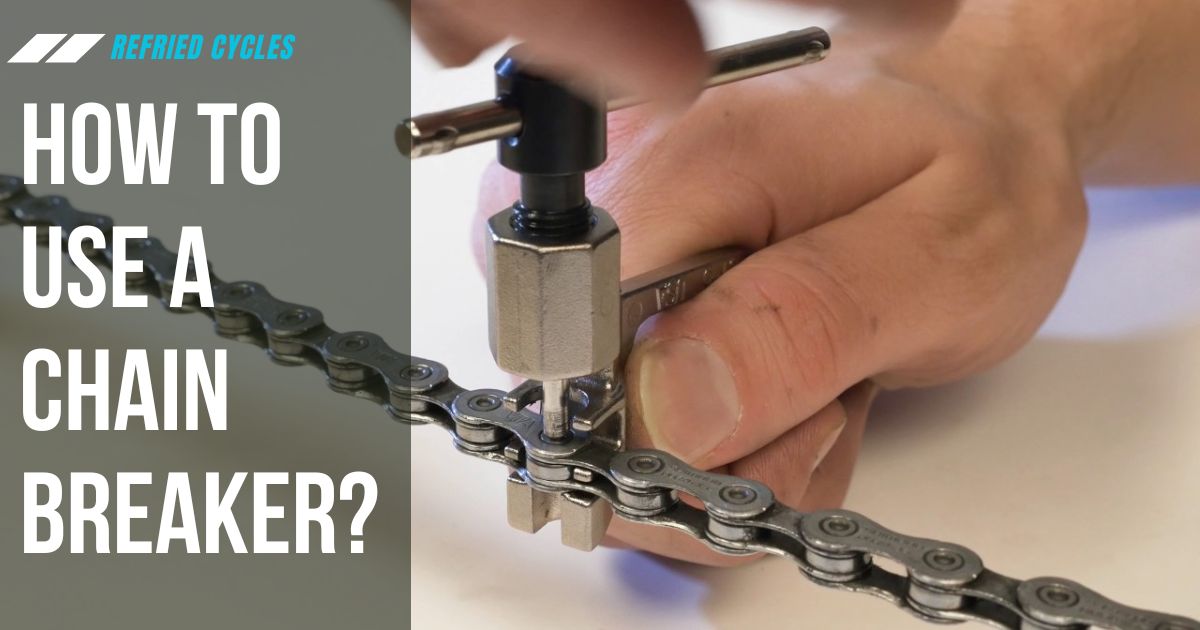Chains are an integral part of many mechanical systems, from bicycles to industrial machinery. Whether you’re a professional mechanic or a DIY enthusiast, understanding how to use a chain breaker is super important for effective chain maintenance and repair. In this guide, we’ll explore the ins and outs of chain breakers, providing you with the expertise to handle chain-related challenges with confidence.
What is a Chain Breaker?
A chain breaker is a specialized tool, indispensable in the toolkit of mechanics and cycling enthusiasts alike. Its primary function is to allow the removal and installation of chain links without damaging the chain itself. The design of a chain breaker is straightforward yet ingenious, facilitating the separation of chain links by breaking the inner plate of the chain. This tool is available in various sizes and styles, each tailored to accommodate different types of chains and their varying thicknesses.
In essence, a chain breaker is a tool that ensures precision and care in handling chains, which are super important components in many mechanical systems. Its design reflects a balance between simplicity and functionality, making it accessible to both professionals and hobbyists.
Why Use a Chain Breaker?
The versatility of a chain breaker extends far beyond simple repair tasks. Here are some key scenarios that highlight its importance:
Chain Replacement
Over time, chains undergo wear and tear, eventually reaching a point where they need to be replaced. This is particularly common in bicycles, motorcycles, and various machinery where chains are constantly in motion. A chain breaker becomes a vital tool in this process, enabling you to remove the old chain safely and efficiently. It ensures that the removal process does not cause any unnecessary strain or damage to the surrounding components.
Chain Shortening
Sometimes, you might find that a chain is too long for your specific drivetrain requirements. This is especially true in custom setups where precise chain length is super important for optimal performance. A chain breaker allows you to adjust the chain to the desired length, making sure that it fits perfectly with your system. This adjustment is super important for maintaining the integrity and efficiency of the drivetrain.
Master Link Installation
Master links are a common feature in modern chains, designed to facilitate easy removal and installation of the chain. They are particularly handy for routine maintenance tasks like cleaning and lubrication. However, installing a master link requires breaking the chain at the appropriate point and then rejoining it using the master link. A chain breaker is the tool of choice for this task, providing the precision and control needed to insert or remove a master link without damaging the chain.
Chain Cleaning and Lubrication
Proper maintenance of chains, including regular cleaning and lubrication, is super important for prolonging their lifespan and making sure smooth operation. However, thoroughly cleaning and lubricating a chain while it’s still on the bike or machinery can be challenging. Removing a section of the chain with a chain breaker allows for more comprehensive cleaning and lubrication, making sure that every part of the chain is well-maintained. This not only extends the life of the chain but also enhances the performance of the entire system.
How to Use a Chain Breaker
Using a chain breaker can seem daunting at first, but with the right approach and tools, it’s a straightforward process. Whether you’re adjusting a bike chain or working on larger mechanical chains, these steps will help you figure out the process of using a chain breaker effectively.
Step 1: Prepare Your Tools and Materials
- Chain Breaker: Select a chain breaker that is compatible with your chain type. Different chains require different chain breakers, so it’s important to use the correct one to avoid damaging the tool or the chain.
- Chain Tool: A chain rivet tool is super important for reattaching links. This tool will help you secure the links back together after breaking the chain.
- Hammer and Punch (Optional): For particularly stubborn rivets, a hammer and punch can be useful. However, use them cautiously to avoid damaging the chain.
- Safety Gear: Safety glasses and gloves are a must. Working with metal can sometimes produce sharp edges or cause small pieces to fly off.
Step 2: Identify the Break Point
- Mark the Link: Clearly mark the chain link where you need to break the chain. This ensures precision in your work and avoids any mistakes.
- Secure the Chain: Before using the chain breaker, make sure the chain is properly secured. This can be done using a vise or by clamping the chain down. A stable chain is easier and safer to work with.
Step 3: Position the Chain Breaker
- Align the Tool: Carefully align the chain breaker’s pin with the marked rivet on the chain link.
- Apply Pressure: Use the screw mechanism or press the handle of the chain breaker to push the rivet out. It’s important to apply steady and even pressure to avoid bending or breaking the chain.
Step 4: Remove the Chain Link
- Extract the Link: Once the rivet is pushed out, you can remove the targeted link.
- Clean the Area: Before reattaching or adjusting further, clean the ends of the chain and the surrounding area. This ensures a smooth reattachment process.
Step 5: (Optional) Reattach the Chain
- Rivet Tool Usage: If you need to reattach the chain, use the chain rivet tool along with a new rivet. Ensure that you follow the tool’s instructions for a secure fit.
- Secure Fastening: Make sure the rivet is securely fastened and the chain links move freely without too much play or stiffness.
Step 6: Enjoy Your Repaired Chain!
Remember, careful work is key to a successful repair. Avoid damaging the chain or surrounding components, use the right tools and techniques, and always refer to the specific instructions for your chain breaker. If you’re unsure or the task seems too complex, don’t hesitate to seek professional help. With practice, using a chain breaker becomes a simple and satisfying task, empowering you to maintain and repair your chains with confidence.
Beyond Breaking: Essential Chain Care Tips
While mastering the use of a chain breaker is super important, it’s just as important to remember that regular chain maintenance is key to extending the lifespan of your chain. Whether it’s a bicycle, motorcycle, or machinery chain, proper care ensures optimal performance and longevity. Here are some super important tips for maintaining your chain:
Regular Cleaning
- Remove Dirt and Grime: Use a dedicated chain cleaner and a brush to thoroughly clean your chain. Dirt and grime can cause accelerated wear and tear, so regular cleaning is vital.
- Method: Apply the cleaner and gently scrub with the brush, making sure to reach between the links. Rinse with water if necessary and dry the chain thoroughly before lubricating.
Consistent Lubrication
- High-Quality Lubricant: Choose a lubricant that is suitable for your chain type. For example, wet lubricants are great for damp conditions, while dry lubricants are ideal for dusty environments.
- Application: Apply the lubricant to each link, making sure even coverage. Wipe off any excess to prevent attracting dirt.
Monitoring Chain Wear
- Check for Stretch: Regularly inspect your chain for stretch or elongation, which can affect the performance of your drivetrain.
- Replacement: If the chain is significantly stretched or shows signs of damage, it’s time to replace it. Using a chain wear indicator tool can help you determine when a replacement is needed.
Conquering the Final Chain-link: Conclusion
Armed with this comprehensive guide, you now possess the knowledge and skills to face any chain-related challenge with confidence. Remember, the secret to successful chain maintenance and repair lies in diligent preparation, correct techniques, and ongoing care. Embracing these practices will guarantee smooth functioning and extend the life of your chain, contributing to a more enjoyable and reliable riding or operating experience.
As you embark on your journey with your chain breaker in tow, ready to tackle any obstacle, remember that the true joy lies in the satisfaction of fixing and maintaining your equipment. It’s a rewarding experience that every enthusiast, whether a cyclist, motorcyclist, or mechanic, should relish.
For more tips, tools, and cycling insights, be sure to visit Refried Cycles, your ultimate resource for all things cycling. Here, you’ll find a community that shares your passion and expertise, ready to help you conquer every mile with confidence.









